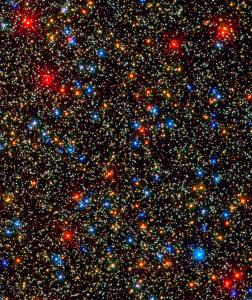
Omega Centauri
A colorful assortment of 100,000 stars resides in the crowded core of Omega Centauri, a giant globular cluster. This is one of the first images taken by the Wide Field Camera 3 (WFC3), installed aboard Hubble during Servicing Mission 4 in May 2009. The camera can snap sharp images over a broad range of wavelengths, including near-infrared light, visible light, and near-ultraviolet radiation. The image, differing from previous Hubble images of Omega Centauri, showcases the camera's color versatility by revealing a variety of stars in key stages of their life cycles. The majority of the stars in the image are yellow-white, like our Sun. These are adult stars that are shining by hydrogen fusion. Toward the end of their normal lives, the stars become cooler and larger. These late-life stars are the orange dots in the image. Even later in their life cycles, the stars continue to cool down and expand in size, becoming red giants. These bright red stars swell to many times larger than our Sun's size and begin to shed their gaseous envelopes. After ejecting most of their mass and exhausting much of their hydrogen fuel, the stars appear brilliant blue. Only a thin layer of material covers their super-hot cores. These stars are fusing helium in their cores. At this stage, they emit much of their light at ultraviolet wavelengths. When the helium runs out, the stars reach the end of their lives. Only their burned-out cores remain, and they are called white dwarfs (the faint blue dots in the image). White dwarfs are no longer generating energy through nuclear fusion and have gravitationally contracted to the size of Earth. They will continue to cool and grow dimmer for many billions of years until they become dark cinders. Other stars that appear in the image are so-called "blue stragglers." They are older stars that acquire a new lease on life when they collide and merge with other stars. The encounters boost the stars' energy-production rate, making them appear bluer. The average distance between any two stars in the cluster's crowded core is only about a third of a light-year, roughly 13 times closer than our Sun's nearest stellar neighbor, Alpha Centauri. If anyone lived in this globular cluster, they would behold a star-saturated sky that is roughly 100 times brighter than Earth's sky. Globular clusters were thought to be assemblages of stars that share the same birth date. Evidence suggests, however, that Omega Centauri has at least two populations of stars with different ages. Some astronomers think that the cluster may be the remnant of a small galaxy that was gravitationally disrupted long ago by the Milky Way. For more information, visit: hubblesite.org/contents/news-releases/2009/news-2009-25.html
- X

























